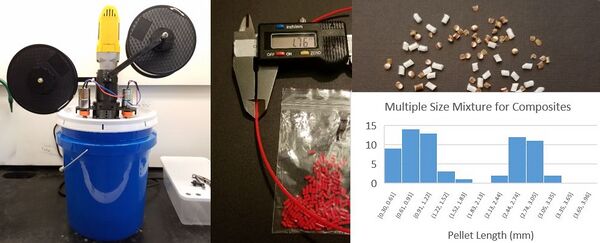J.M.Pearce (talk | contribs) |
J.M.Pearce (talk | contribs) m (→Source) |
||
| Line 3: | Line 3: | ||
==Source== | ==Source== | ||
* Aubrey L. Woern and Joshua M. Pearce. 3-D Printable Polymer Pelletizer Chopper for Fused Granular Fabrication-Based Additive Manufacturing. ''Inventions'' 2018, 3(4), 78; https://doi.org/10.3390/inventions3040078 [ open access] | * Aubrey L. Woern and Joshua M. Pearce. 3-D Printable Polymer Pelletizer Chopper for Fused Granular Fabrication-Based Additive Manufacturing. ''Inventions'' 2018, 3(4), 78; https://doi.org/10.3390/inventions3040078 [https://www.academia.edu/37860682/3-D_Printable_Polymer_Pelletizer_Chopper_for_Fused_Granular_Fabrication-Based_Additive_Manufacturing open access] | ||
** Just the code: https://osf.io/6t4dn/ | ** Just the code: https://osf.io/6t4dn/ | ||
** STLs alone: | |||
==Abstract== | ==Abstract== | ||
Revision as of 13:28, 27 November 2018
Source
- Aubrey L. Woern and Joshua M. Pearce. 3-D Printable Polymer Pelletizer Chopper for Fused Granular Fabrication-Based Additive Manufacturing. Inventions 2018, 3(4), 78; https://doi.org/10.3390/inventions3040078 open access
- Just the code: https://osf.io/6t4dn/
- STLs alone:
Abstract

Although distributed additive manufacturing can provide high returns on investment, the current markup on commercial filament over base polymers limits deployment. These cost barriers can be surmounted by eliminating the entire process of fusing filament by three-dimensional (3-D) printing products directly from polymer granules. Fused granular fabrication (FGF) (or fused particle fabrication (FPF)) is being held back in part by the accessibility of low-cost pelletizers and choppers. An open-source 3-D printable invention disclosed here allows for precisely controlled pelletizing of both single thermopolymers as well as composites for 3-D printing. The system is designed, built, and tested for its ability to provide high-tolerance thermopolymer pellets with a number of sizes capable of being used in an FGF printer. In addition, the chopping pelletizer is tested for its ability to chop multi-materials simultaneously for color mixing and composite fabrication as well as precise fractional measuring back to filament. The US$185 open-source 3-D printable pelletizer chopper system was successfully fabricated and has a 0.5 kg/h throughput with one motor, and 1.0 kg/h throughput with two motors using only 0.24 kWh/kg during the chopping process. Pellets were successfully printed directly via FGF as well as indirectly after being converted into high-tolerance filament in a recyclebot.
Keywords
additive manufacturing;Circular economy; Distributed recycling; Energy conservation; Polymer recycling; Sustainable development; distributed manufacturing; life cycle analysis; recycling; recyclebot; 3-D printing; Open source hardware; Open hardware; RepRap; Recycling; Polymers; Plastic; Recyclebot; Waste plastic; Composites; Polymer composites; Extruder; Upcycle; Materials science;additive manufacturing; distributed manufacturing; open-source; extruder; upcycle; 3-D printing; waste plastic;
See Also
- Fused Particle Fabrication 3-D Printing: Recycled Materials’ Optimization and Mechanical Properties
- Recyclebot
- Tightening the loop on the circular economy: Coupled distributed recycling and manufacturing with recyclebot and RepRap 3-D printing
- Energy Payback Time of a Solar Photovoltaic Powered Waste Plastic Recyclebot System
- Wood Furniture Waste-Based Recycled 3-D Printing Filament
- Life cycle analysis of distributed recycling of post-consumer high density polyethylene for 3-D printing filament
- Evaluation of Potential Fair Trade Standards for an Ethical 3-D Printing Filament
- Mechanical Properties of Components Fabricated with Open-Source 3-D Printers Under Realistic Environmental Conditions
- Mechanical testing of polymer components made with the RepRap 3-D printer
- Development and feasibility of applications for the RepRap 3-D printer
- Life cycle analysis of distributed polymer recycling
- Solar powered distributed customized manufacturing
- Distributed recycling of post-consumer plastic waste in rural areas
- Ethical Filament Foundation
- Economist article on U. of Washington's HDPE boat, Oprn3dp.me
- Cruz, F., Lanza, S., Boudaoud, H., Hoppe, S., & Camargo, M. Polymer Recycling and Additive Manufacturing in an Open Source context: Optimization of processes and methods. http://sffsymposium.engr.utexas.edu/sites/default/files/2015/2015-127-Cruz.pdf
- https://ultimaker.com/en/resources/52444-ocean-plastic-community-project





